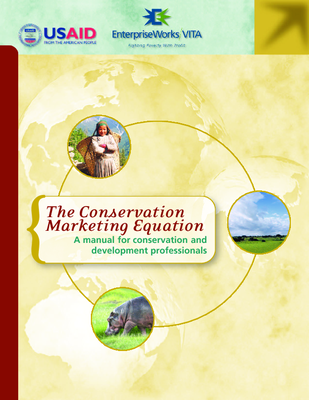Conservation Marketing Equation: A Manual for Conservation and Development Professionals

Key points in document
- The manual is designed to guide project teams through the process of product development and marketing for project enterprises that support both conservation and social equity.
- The manual aims to assist planners in the process of identifying and selecting opportunities, defined as “products or services,” that will achieve conservation success while reducing poverty.
- Field examples from the document are from EnterpriseWorks/VITA projects located in Asia, Africa, and Latin America. There is advice, as well as worksheets, for practitioners at the end of the manual.
- The enabling conditions addressed with the most detail in the manual include business aspects, regulatory compliance, and technical skills.
- Guidance includes market definition (such as identifying demand and target consumers) and product definition (such as price, quality, and quantity).
- The manual guides users through the steps to defining product “regulations” and “certification.” In some cases, laws may prohibit the sale of certain products, or limit their output at a local or national level; compliance with these regulations is necessary for enterprise success. The report helps the user identify these regulations and separate them from certifications. Certifications are often voluntary, though may be very useful for the enterprise under the correct circumstances. For instance, products that are certified “organic” are currently in high demand.
- The manual provides guidance on understanding the value chain of a product, including the stakeholder involved and their technical skill requirements.
Information relevant to Learning Questions:
Are enabling conditions in place to support a sustainable enterprise?
- Market demand, profit potential
- Government requirements, policies for enterprises, business alliances
- Technical capacity
- Biodiversity linkage, policies for and enforcement of resource use
Does the enterprise lead to benefits to stakeholders?
- Increased income for participants
Do the benefits lead to positive changes in attitudes and behavior?
- Behaviors regarding sustainable use of resources
Does a change in stakeholders’ behaviors lead to a reduction to threats to biodiversity (or restoration)?
- Agriculture and aquaculture
- Biological resource use
- Human intrusions and disturbance
- Natural system modifications
Does a reduction in threats (or restoration) lead to conservation?
- Forest ecosystems
- Species


